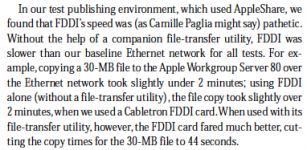The problem was that Apple tied the two channels together on any Mac that had a chance to compete with the $3,000 Dell you mentioned. Limiting the LC, LCII, LCIII and CC to mono output was a big mistake IMO as that was the period in which the PC became the platform of choice for gaming. That was a bmajor factor after the release of Windows 3.0 which included Sound Blaster drivers.
The original Sound Blaster was also a mono device. The SoundBlaster Pro, circa mid 1991, rectified that, sort of (as NJRoadfan points out) but low-end mono 8-bit Soundblasters (and compatibles) were present on the market for a *long* time even after the Soundblaster 16 was introduced in 1992. So, again, if you're comparing "Apples" to Apples, IE, low-end machines, you're once again pretty much breaking even feature-wise when you compare an LC-series Mac to a low-end "cheap and cheerful" gaming PC.
I've been talking about perceived value.
Let's think yet a little more about "value". There's no way an LC could be considered a competitor to that $3000 Dell; I picked that machine as an example because at the time it was a premium, stylish, small-footprint "Executive Workstation", IE, I tried to find something that you'd actually reasonably cross-shop against a Quadra 700. A Dell 486P/33 would *easily* run rings around an LC II, it's not even close. (16mhz 68030 *on a 16 bit bus* vs. 33mhz 486.) Let's figure out what a potential LC buyer in January 1992 would actually be cross-shopping against. (Picking that because I have the handy list of "street prices" from omidimo above.) I'll choose the base-most 2/40mb config at $1595 and add an Apple 13" monitor at $665, for a total entry price of $2260, and to whatever PC I pick out I'll add the price of a soundblaster card (Found an ad selling it $169, so that's our reference there.). I'll break this into two categories: PCs you could buy for the same *price*, and a PC that's actually roughly comparable in terms of features, and I'll also break it down into "brand name" verses "randomly chosen from one of those sketchy ads in the back".
In the "sketchy white box" category, from an outfit called "Microline Computers" I can get in the "feature match" category:
386sx/25 with 2MB RAM (expandable to 8mb), 52MB HD, 512k VGA card, Relisys 14" 1024x768 (interlaced) SVGA monitor, keyboard, mouse, MS-DOS+Windows 3.0+soundblaster: $1,434.
Best price match:
386DX/33 w/64k cache SRAM and 4MB RAM (expandable to 32mb), 120MB HD, 1MB VGA card, non-interlaced 14" 1024x768 SVGA, DOS+Windows 3.0 + soundblaster: $1964.
(Price match was a tough call, because for the $2260 target you get to choose between a really tricked out 386 or a stripped 486. I went with the 386 figuring you could stand to spend the money on more RAM. It also sort of reflects a more realistic cost of the LC if you bought a non-Apple monitor.)
For the "name brand" I went with Gateway 2000 because their ad actually had convenient prices printed on it, Dell's was a hot "call us" mess. From them, the feature match:
386sx/16, 4MB RAM, 512k VRAM, 40MB drive, 14" monitor, etc, etc, Soundblaster: $1614
And the price match:
386DX/33, 4MB, 1MB VRAM, 120MB HD, 14" monitor, etc, Soundblaster: $2314
(Yeah, this time I erred on the high side by $50. I picked it because it's the same config as the completely no-name machine; the roughly $400 premium for coming from a prettier ad also roughly reflects what you'd pay if you bought a "white box" from a local computer store instead of mail order. Of course, if you went to a local computer store for your Mac you'd probably be paying more than that gray-market ad's prices too.)
I think the thing that becomes readily apparently when you make a comparison like this is that not only is the price of entry significantly lower for a PC, the huge price gap that existed between Apple's bottom-of-the-barrel systems and their "mainstream" business Macs simply didn't exist in the PC world. To make the jump from an LC to a IIci (a machine that compares pretty evenly to the 386 I chose in the "price match" configs) nearly doubles the price of the machine, while in the PC world it's only about a 50% premium for a machine that'll easily be twice as fast. (This price-performance curve actually gets really bad if we chose the IIci as our comparison bait, because its entry price is deep in brand-name 486DX territory. You can get an EISA machine with a 340MB SCSI hard drive for about the price of the 8/240 IIci. Or, more reasonably climbing up the ladder from the 386 config, you can make that a name brand 486/33 with a 200mb IDE drive and undercut the 8/105 IIci by about $400.)
Apple's problem is simply that they cost too darn much for most people. I seriously doubt more slots would have tilted the scales much.



